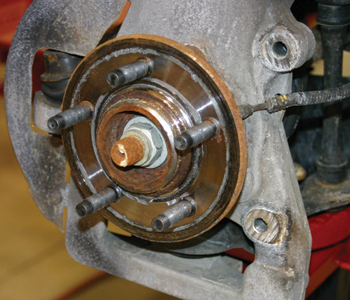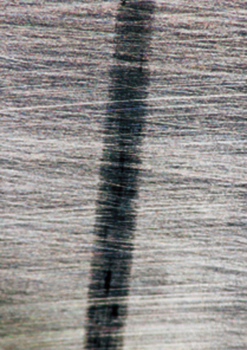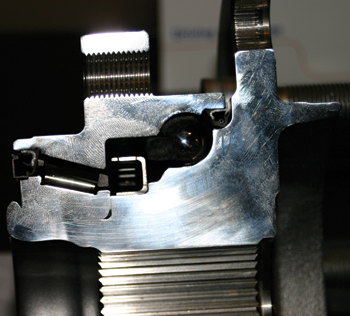 In the good old days, most serviceable wheel bearings were maintained at least every 25,000 to 30,000 miles during a brake job. During this process, races, stub-axles and cages could be inspected for damage and replaced if necessary. Today, the average life of a sealed wheel bearing or hub assembly is about 85,000 to 100,000 miles. But they can fail sooner than expected without a whisper.
In the good old days, most serviceable wheel bearings were maintained at least every 25,000 to 30,000 miles during a brake job. During this process, races, stub-axles and cages could be inspected for damage and replaced if necessary. Today, the average life of a sealed wheel bearing or hub assembly is about 85,000 to 100,000 miles. But they can fail sooner than expected without a whisper.
The final signs of failure are noise and play. These two symptoms are the last phases of a failure that started a long time ago. But, many bad bearings may never make a peep or grumble, but they can cause vibrations and problems with the brake system.
The old-school test of pulling on the wheel at 12- and six-o’clock still applies, but you will only be catching the really bad bearings. New techniques can help you spot bad bearings and work smarter, not harder.
What Kills Bearings?
Loads at a vehicle’s corners are concentrated on the relatively small bearing surfaces. All of the weight on some vehicles may rest on an area no larger than the area the size of a business card. Loads that are put on the bearing are called thrust and radial loads.
 When a vehicle hits a curb, pothole or other object in its path, the force is transferred to the small surface area of the bearing. The impact may cause damage to the races and the rollers/balls. This damage is called Brinelling.
When a vehicle hits a curb, pothole or other object in its path, the force is transferred to the small surface area of the bearing. The impact may cause damage to the races and the rollers/balls. This damage is called Brinelling.
Brinelling is a material surface failure/defect caused by contact stress that exceeds the material’s hardness limit. It is caused by impact great enough to exceed the material’s hardness. The result is a permanent dent or “Brinell” mark.
Brinell marks may cause the bearing to make noise immediately or it may not. But, as the marks keep rotating, it could be damaging the entire bearing. If the impact is great enough, the pre-load on the bearing can change. This can lead to more damage and noise.
Flange Damage
The health of the wheel bearing’s flange is a direct indicator of the overall health of the bearings inside. If a wheel has endured an impact strong enough to cause damage to the bearings and races, chances are the flange is distorted.
 A distorted flange will have runout. This runout can cause vibration and eventually disc thickness variation in the brake rotors. Every manufacturer has its own specification for wheel flange runout. Most specifications fall between 0.0015” and 0”. Most manufacturers are moving to a zero runout and endplay specification in the flange. This “perfect” specification is because any runout in the flange will be magnified by the rotor.
A distorted flange will have runout. This runout can cause vibration and eventually disc thickness variation in the brake rotors. Every manufacturer has its own specification for wheel flange runout. Most specifications fall between 0.0015” and 0”. Most manufacturers are moving to a zero runout and endplay specification in the flange. This “perfect” specification is because any runout in the flange will be magnified by the rotor.
If a flange has .001” of runout, a 10” rotor may have .003” of total runout when mounted. If this vehicle is riding on 205/55R16 tires, in one mile, the high-spot with .003” of runout goes past the caliper approximately 836 times. Over 6,000 miles, the spot on the rotor will go past the pads more than 5 million times! Every time this spot passes the pads, a little bit of the rotor’s material is removed. Over 5-million revolutions, enough material is removed to create a thickness variation that can be felt by the driver.
Some amount of runout can be corrected by an on-the-car brake lathe. But if the runout is too great, the life of the rotor is compromised by removing too much material to correct the runout. Also, runout in the flange can be corrected with plates that fit between the rotor and flange. But, if the runout is excessive and can not be brought within specifications, the only option is to replace the flange and/or bearing.
Wheel Speed Sensors Signals
Most vehicles with hub units are using tone rings mounted inside the wheel bearing hub unit. Most unitized hub units place the tone ring between the inner bearing races.
The air gap on these sensors is very precise. If there is play in the inner or outer bearing, it will be detected by the sensor and ABS/ESC computer. The computer will typically set a chassis trouble code for the erratic signal for each corner of the vehicle.
If you have a scan tool that can access the PIDs and data for the wheel speed sensors, it is possible to observe play in the bearings as the car corners and brakes. Speeds may drop dramatically when compared to the inputs from the other wheels. If the ABS/ESC system detects this, it will disable the system and illuminate the ABS light on the dash.
If a vehicle has these symptoms, it is a no-brainer to replace the bearing or hub unit even if it is not making noise or no play is present.
Replacement
A high quality bearing is key to performing a comeback-free job. High quality hub units or bearings typically use higher-quality materials and heat-treating processes that make for harder surfaces. The harder surfaces will not “Brinell” under hard impacts.
When replacing a hub unit, the replacement unit might feel stiff and difficult to turn. Do not return the bearing. Some hub units and sealed bearing are being filled with a special grease that prevents damage while the bearing is being shipped. The grease is designed to have a high viscosity during shipping so the balls or rollers do not destroy the surfaces of races. After the bearing is installed, certain elements in the grease break down and the bearing turns normally.
While it may appear to be easier to use an impact wrench, it is not recommended. OEM and bearing manufacturers always recommend using a torque wrench for installation. During removal, an impact wrench can damage the axle nut threads and shock the CV joints. It can also create a false sense of security when adjusting a nut or bolt, which may be under or over torqued. This can leave a hub assembly susceptible to failure. Also, in almost all cases, use a new axle nut. Some axle nuts are designed to be used only once, and cannot be adjusted.
Bearing FAQ’s
1. Why are more vehicles using hub assemblies today?
Hub assemblies are unitized, maintenance free and non-serviceable units that are preset, pre-greased and pre-sealed, making installation easier and increasing product reliability for enhanced performance. These hubs require no maintenance or handling, which eliminates the need for preventive maintenance, grease and/or future adjustments.
2. Can I use an impact wrench to remove or install a hub assembly?
While it may appear to be easier to use an impact wrench, it is not recommended. We recommend the use of a certified, calibrated torque wrench. Impact wrenches can damage the axle nut, threads and components. It can also create a false sense of security when adjusting a nut or bolt, which may be under- or over-torqued. This can leave a hub assembly susceptible to failure.
3. Do I need to torque the axle nut and/or the lug nut?
Yes. It is imperative that you follow the manufacturer’s specifications and/or instruction manual to ensure the hub is installed correctly. Failure to follow the manufacturer’s installation instructions and follow the proper installation procedures can cause equipment failure, creating a risk of serious bodily harm.
4. Can I replace the bearings or seals in my hub assembly?
No, because the hub assemblies are unitized, maintenance free and non-serviceable. Most hub assemblies are designed with a unitized bearing or flange that is intricate to the hub and/or bearing housing, which are not replaceable.
5. Do wheel studs come with all hub assemblies?
No. While most hub assemblies do include the wheel studs, there are some that do not. Timken does not recommend reusing the old studs with the new hub assembly.
Courtesy of The Timken Company.






